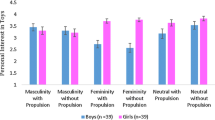Abstract
A developmental model of gender-stereotype acquisition (Martin, 1989) proposes that by the age of 8 years children draw upon information about gender-stereotyped interests as well as other children's sex when deciding how much other children would like different activities; younger children rely on sex only when making such decisions. We examined whether the judgments that children made about other children's preferences were different from those that they made about their own preferences for masculine and feminine musical instruments. Three hundred twelve children aged 8–9 years ranked 6 instruments in order of preference, and rated on a 4-point scale how much they would like to play each one. Children were then asked to decide how much other children would like to play each instrument. Only girls' own preferences for feminine instruments differed according to the gender-stereotyping of their most-preferred instrument. Judgments about how much other children would like masculine and feminine instruments did not differ according to those children's gender-stereotyped interest. Children made stereotypical predictions about the preferences of children of unknown sex who played either a masculine or feminine instrument. Implications for a theoretical account of the development of children's gender-stereotypes are discussed.
Similar content being viewed by others
References
Abeles, H. F., & Porter, S. Y. (1978). The sex-stereotyping of musical instruments. Journal of Research in Music Education, 26, 65-75.
Bauer, P. J., & Coyne, M. J. (1997). When the name says it all: Preschoolers' recognition and use of the gendered nature of common proper names. Social Development, 6, 271-291.
Berndt, T. J., & Heller, K. A. (1986). Gender stereotypes and social inferences: A developmental study. Journal of Personality and Social Psychology, 50, 889-898.
Biernat, M. (1991). Gender stereotypes and the relationship between masculinity and femininity: A developmental analysis. Journal of Personality and Social Psychology 61, 351-365.
Crowther, R. D., & Durkin, K. (1982). Sex and age related differences in the musical behavior, interests and attitudes towards music of 232 secondary school students. Educational Studies, 8, 131-139.
Deaux, K., & Lewis, L. L. (1984). Structure of gender stereotypes: Interrelationships among components and gender label. Journal of Personality and Social Psychology, 46, 991-1004.
Delzell, J. K., & Leppla, D. A. (1992). Gender associations of musical instruments and preferences of fourth-grade students for selected instruments. Journal of Research in Music Education, 40, 93-103.
Edelbrock, C., & Sugawara, A. I. (1978). Acquisition of sex-typed preferences in pre-school aged children. Developmental Psychology, 14, 614-623.
Gelman, S. A., & Markman, E. M. (1987). Young children's inductions from natural kinds: The role of categories and appearances. Child Development 58, 1532-1541.
Griswold, P. A., & Chroback, D. A. (1981). Sex-role associations of music instruments and occupations by gender and major. Journal of Research in Music Education 29, 57-62.
Harrison, A. C., & O'Neill, S. A. (2000). Children gender-typed preferences for musical instruments: An intervention study. Psychology of Music, 28, 81-97.
Huston, A. C. (1983). Sex-typing. In P. H. Mussen & E. M. Hetherington (Eds.), Handbook of child psychology: Vol. 4. Socialisation, personality, and social behavior (pp. 387-467). New York: Wiley.
Livesley, W. J., & Bromley, B. D. (1983). Person perception in childhood and adolescence. New York: Basic Books.
Lobel, T. E., Bar-David, E., & Gruber, R. (2000). Gender schema and social judgments: A developmental study of children from Hong Kong. Sex Roles, 43, 19-42.
Locksley, A., Borgida, E., Brekke, N., & Hepburn, C. (1980). Sex stereotypes and social judgments. Journal of Personality and Social Psychology, 39, 821-831.
Martin, C. L. (1989). Children's use of gender-related information in making social judgments. Developmental Psychology, 25, 80-88.
Martin, C. L. (1993). New directions for investigating children's gender knowledge. Developmental Review, 13, 184-204.
Martin, C. L., Eisenbud, L., & Rose, H. (1995). Children's gender-based reasoning about toys. Child Development, 66, 1453-1471.
Martin, C. L., Wood, C. H., & Little, J. K. (1990). The development of gender stereotype components. Child Development, 61, 1891-1904.
O'Neill, S. A., & Boulton, M. J. (1996). Boys' and girls' preferences for musical instruments: A function of gender? Psychology of Music, 24, 171-183.
Serbin, L. A., Powlishta, K. K., & Gulko, J. (1993). The development of sex typing in middle childhood. Monographs of the Society for Research in Child Development, 58(2, Serial No. 232).
Author information
Authors and Affiliations
Corresponding author
Rights and permissions
About this article
Cite this article
Harrison, A.C., O'Neill, S.A. Preferences and Children's Use of Gender-Stereotyped Knowledge About Musical Instruments: Making Judgments About Other Children's Preferences. Sex Roles 49, 389–400 (2003). https://doi.org/10.1023/A:1025168322273
Issue Date:
DOI: https://doi.org/10.1023/A:1025168322273




